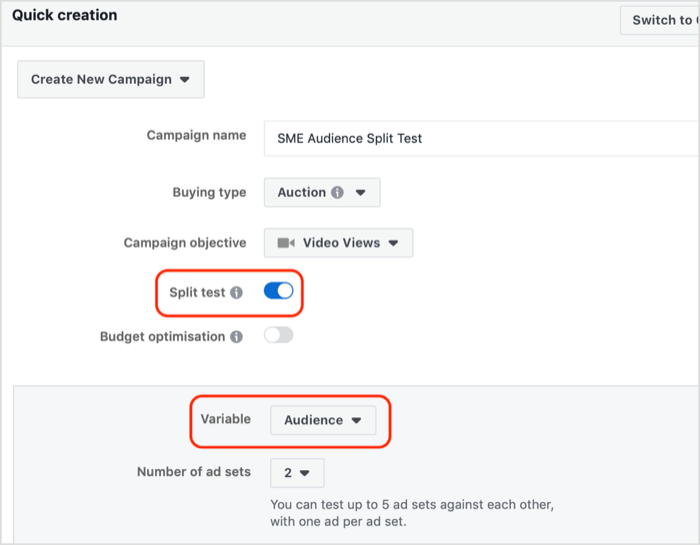4 Key Methods to Optimise Facebook Ads for Conversions
Facebook ads are another way of reaching a very specific audience. And while there are more than 2 billion users on the platform, it also allows you to handpick the most profitable profiles that meet the criteria of becoming your potential clients. The difference between a properly optimised Facebook ads campaign and a poorly managed […]

Facebook ads are another way of reaching a very specific audience. And while there are more than 2 billion users on the platform, it also allows you to handpick the most profitable profiles that meet the criteria of becoming your potential clients.
The difference between a properly optimised Facebook ads campaign and a poorly managed one can be the success or failure of your business. Facebook has a reach no other platform can offer. Let’s see how to use its power at the fullest.
How to create the best Facebook ads
In order to optimise a campaign, first, you need to make one. And if the campaign is poorly done, it is better to start anew. What makes a good Facebook ad work?
1. Persuasive and Comprehensive Copywriting

Some copies explain everything in detail but miss sharing the key selling points with the users. Others lack the details needed to convert someone into a visitor. All ad copies should battle the major objection, be concise and clear, and include a CTA (Call to action). To do this, you should:
- Make sure your CTAs stand out. (You can highlight them, bold them, misplace them, etc.)
- Create urgency. (Limited offer, 10 hours remaining, the first 100 to buy receive a 50% discount, and so on.)
- Use clear CTAs, (Buy now, subscribe, purchase, enrol.) Let people know what they are paying for.
- Make your ads concise by using bullet points.

As you can see in the image above, Quickbooks, accounting software for small and medium businesses have followed all the guidelines.
- What stands out about this offer, is that they give you a 50% discount if you subscribe now.
- The benefit that’s being sold to the client is very clearly stated: “Manage your business on the go – anywhere and anytime.”
- Moreover, you can see the call to action in two places. On the left – “Subscribe today and save” and on the right in the form of the button “Subscribe”.
Another great practice is to include a question and engage your audience. But this one can be quite tricky and can be shown with another example.
The question can be included at the beginning of the copy to entice the users like here:

Doordash has used the very smart way of letting you know who this offer is for. It’s a simple, yet very effective question. Do you run a restaurant?
If yes, then come along and try us for free.
If not, pass by, no need to waste our budget on your clicks.
On the other hand, there are many other ways to include a question in your copy. A good example here is SEMrush’s campaign.

The question here is used to prompt people to click more on the CTA on the right side of the ad.
2. Visuals make the magic

Did you know that ads and posts in the Facebook feed perform over 40 % better when they have an engaging image or video included in the post?
People like visuals. Then, you should definitely invest in a good, eye-catching design.
Aside from other major platforms like Tik Tok, YouTube and Instagram, Facebook is also a place where a big portion of the users prefer watching videos.
A good combination of video and image ads can ensure that your campaigns reach more people.
In order to ensure good visuals:
- Play with colours. Make sure you get a good idea of how separate colours are perceived and what they mean in the mind of your visitors.
- Create a brand image and follow it. Brand recognition and brand awareness play an important part in being chosen over your competitors in the niche.
- Use similar colours, buttons, shapes, and visuals throughout the social media feed of your brand.
Depending on what your brand has to say, and whether it promotes neutrality, aggressive energy (like an energy drink), or calm (like a meditation app), you should choose different patterns.
You can read more on colour combinations and how they work in social media branding in creatopy.com’s blog post here.
3. With Facebook ads, the right ad format makes all the difference

The good thing about Facebook ads, aside from the wide reach, and precise targeting is that there are many ad formats to choose from.
You can dive into and explore:
- Carousel Ads
- Video Ads
- Ads optimised for stories
- Native ads
- Banner Ads
- Display Ads
- Promoted posts
There are also other options and combinations, but let’s break down what type of ad you should go for, depending on your goals.
You should take into account various questions before choosing the ad format. These are:
- What are your advertising goals?
- What is your Facebook advertising budget?
- How many products are you promoting with one advertisement?
- Do you want your ad to look organic, or to stand out from the feed?
Advertising goals
There are three main types of advertising goals that you can choose in Facebook when setting up a campaign. These are:
- Awareness
- Consideration
- Conversion
Awareness is generally used to introduce your brand to potential customers and let them get familiar with seeing your brand.
Consideration is another set of Facebook ads objectives that encourage users to try and reach out for more information on your products or services.
Conversions objectives are the ones that aim to drive people to convert and make a purchase or to perform a certain conversion event on your websites, such as a registration, a subscription, or something else.

The image above shows a single image ad, but before you dive into one, make sure you get familiar with the dimensions and formats of all Facebook ads. You can read more on the dimensions, in madgicx’s article here.
Promoting more than one product? If you are promoting more than one product, either choose a video or a carousel format. These two work best for the simultaneous promotion of more than one service or product.
Native ads. If you want your ad to blend in and get a higher CTR (click-through-rate), read more on native ads, and how to create one, without violating regulations. You can read Facebook’s official guide here.
Having a low ad budget? Boost a post that is already performing well, and you’ve written in the past. This way you will save money from writing a new copy, and getting a new image.
4. Analyse your Facebook ads performance and optimise them

There are a ton of social media tools that you can use to monitor the performance of your ads, aside from the Facebook dashboard and analytics.
You can use smart tools like social media listening, to know what your followers are interested in and what their concerns are. This can greatly save you some time in figuring out what your next posts should look like, and what the key points you need to address are.
Moreover:
- Analyse individual ad performance and measure the reception in different audience segments.
- Use Facebook’s test audiences and determine which one works the best for your business.
- A/B tests are a great way of finding out what works and what doesn’t. Some ads are greatly written but won’t resonate with the target audience that you choose. Switch things around and see how things work out.
If you are unfamiliar with A/B testing and its potential, you can read more on A/B testing general principles in our blog posts here.
Aside from conversions, there are other things that you can track with the help of Facebook analytics. These are:
- Impressions: Impressions tracking are a great way of knowing how often your content is viewed without being clicked.
- Reach: The reach is the number of people seeing your ads. The difference between impressions and reach is that if 100 people have seen your ads 50 times each, you would have a reach of 100. At the same time, your impressions are 50*100 = 5000 impressions.
Evaluate your campaigns for the metric that you have optimised them for. For example, if you are optimising for conversions, the number of impressions wouldn’t be as important, as it would eventually grow. In that case, what matters is the CTR of the ad.
Another thing to monitor is engagement rates. If you want to go viral with a funny post, or a social meme, then monitoring these can be the key to success for your next post. Don’t be afraid to steal ideas from your audience. These events count as engagement:
- Likes
- Clicks
- Shares
- Comments
- Mentions, Tags

Conclusion
Facebook can be used for a wide variety of goals, and the tools it offers are quite a few. Make sure to properly determine your audiences, and target them with specific ad formats that work for the goal you’ve chosen.
Regardless of the format you go for, utilise smartly polished precise copywriting, and eye-catching visuals that resonate with your brand and followers. Split test ad copies and optimise your campaigns by choosing the better-performing ones. That would ensure an increase in engagement and conversions.

